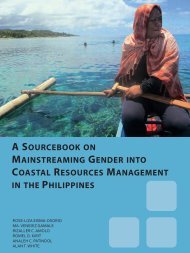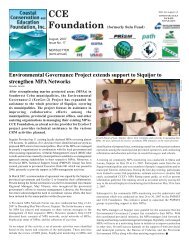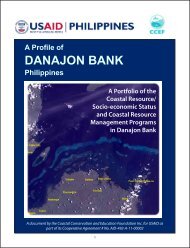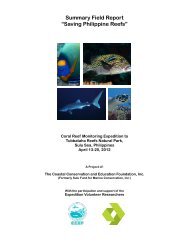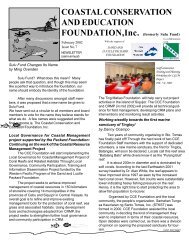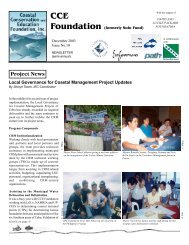Marine Protected Area Management Effectiveness: Progress and ...
Marine Protected Area Management Effectiveness: Progress and ...
Marine Protected Area Management Effectiveness: Progress and ...
Create successful ePaper yourself
Turn your PDF publications into a flip-book with our unique Google optimized e-Paper software.
Downloaded by [Alan T. White] at 14:04 18 September 2012<br />
512 A. P. Maypa et al.<br />
Kelleher, Bleakley, <strong>and</strong> Wells (1995) estimated that MPA effectiveness to be 10–15% from<br />
a sample of approximately 100 MPAs. Then Arceo, Aliňo, <strong>and</strong> Gonzales (2008) suggested<br />
an improvement to 20–30% effective. This is concordant with the assessment of Alcala,<br />
Bucol, <strong>and</strong> Nillos-Kleiven (2008) estimating 30% of the MPAs in the Visayas <strong>and</strong> Mindanao<br />
being effective.<br />
Quantifying MPA management effectiveness as defined by Pomeroy, Parks, <strong>and</strong> Watson<br />
(2004) in the Philippines, <strong>and</strong> defining what that means in the eyes of MPA managers <strong>and</strong><br />
stakeholders is crucial information to assist managers <strong>and</strong> planners to help MPAs meet their<br />
goals as numbers of MPAs increase. As new MPAs are established <strong>and</strong> implemented through<br />
local governments (Aliño et al. 2002; PhilReefs 2008; Weeks et al. 2009), it is important to<br />
determine the management <strong>and</strong> information gaps <strong>and</strong> to reverse the trends of inappropriate<br />
<strong>and</strong> weak implementation. Thus, this study used an existing MPA management effectiveness<br />
evaluation system (see Methods) to determine the overall status of MPAs, to what extent<br />
their management is improving <strong>and</strong> to isolate key factors that affect the success or failure<br />
of MPAs in the country.<br />
Methods<br />
Background<br />
Several methods have emerged to measure MPA effectiveness <strong>and</strong> are being developed globally,<br />
with some for local use (e.g., Pomeroy, Parks, <strong>and</strong> Watson 2004; Carter, Soemodinoto,<br />
<strong>and</strong> White 2010; Staub <strong>and</strong> Hatziolos 2004). In the Philippines, there has been a need to<br />
st<strong>and</strong>ardize <strong>and</strong> fine tune existing MPA evaluation measures to a more comprehensive, community<br />
friendly <strong>and</strong> culturally sensitive assessment system. Since 2001, the MPA Rating<br />
System1 (White, Aliňo, <strong>and</strong> Menesses 2006) developed by the Coastal Conservation <strong>and</strong><br />
Education Foundation, Inc. (CCE Foundation) working with key organizational partners,<br />
has become a popular management effectiveness tool nationwide. It is an evaluation tool<br />
for MPA managers that helps assess the progress of a MPA over time in five levels (White,<br />
Aliňo, <strong>and</strong> Menesses 2006) (Table 1) <strong>and</strong> includes a set of MPA management activities or<br />
criteria that serve as a checklist of past, present, <strong>and</strong> future projects for the enhancement<br />
of the MPA management. The MPA rating tool was first disseminated in coordination with<br />
the collaborators of CCE Foundation’s MPA Project in 2003 <strong>and</strong> has since been adopted<br />
by members of the MPA Support Network (MSN) <strong>and</strong> the League of Municipalities of the<br />
Philippines (LMP). 2<br />
Using the 2008 version of the MPA Rating System which is a point achievement system<br />
(Table 1) similar to the World Bank scorecard approach (Staub <strong>and</strong> Hatziolos 2004),<br />
we measured progress toward management effectiveness in Philippine MPAs by assessing<br />
MPA levels as determined by applying a checklist of actions or prerequisites for MPA management<br />
enhancement (White, Aliňo, <strong>and</strong> Menesses 2006). We also identified management<br />
gaps <strong>and</strong> priorities in meeting goals. Finally, a subset of comprehensive biophysical data<br />
for MPAs in the Visayan region (not available nationally) was analyzed in relation to the<br />
MPA Rating System to measure impacts of local government capacity-building efforts (or<br />
governance) on MPA coral reef health. This additional analysis constitutes a “case study”<br />
for the Central Visayas, an area that has benefitted from the operation of several coastal<br />
resource management projects that has increased the capacity of municipal governments<br />
in the area to support MPAs <strong>and</strong> fisheries management (Eisma-Osorio et al. 2009; Bendijo



